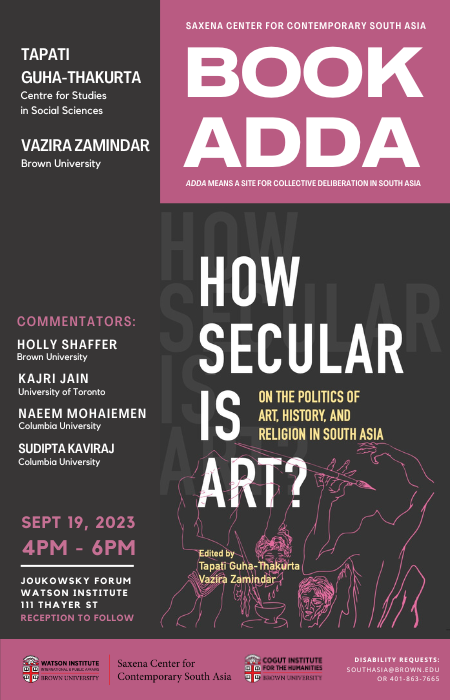Vazira Fazila-Yacoobali Zamindar is Associate Professor of History at Brown and works on decolonization, displacement, war, non-violence, anticolonial practice, the visual archive and contemporary art. She is the author The Long Partition and the Making of Modern South Asia: Refugees, Boundaries, Histories (Columbia University Press, 2007) and over the last decade she has been working on a book on archaeology, art history, photography, film, war and the anticolonial struggle on the Indo-Afghan borderlands. She recently had a solo show entitled Anticolonial based on this work at the Canvas Gallery in Karachi, Pakistan (June 6-16, 2023) and is working on a graphic novel with Sarnath Banerjee on Gandhi and Abdul Ghaffar Khan. She co-organized the Brown-Harvard Pakistani Film Festivals of 2014 and 2015 which resulted in the co-edited collection Love, War and Other Longings: Essays on Cinema in Pakistan (Oxford University Press, 2020). In 2018, she initiated the series Art History from the South (2018-2020) and this co-edited book How Secular is Art? On the Politics of Art, History and Religion in South Asia (Cambridge University Press, 2023) and the co-edited special issue of Art Margins, entitled Art History, Postcolonialism and the Global Turn (July 2023) emanate from its lines of enquiry. She has also written on the work of artists Sadequain, Zarina, Bani Abidi, Beate Terfloth and Huma Bhabha.
Tapati Guha-Thakurta is Honorary Professor of History and the former director of the Centre for Studies in Social Sciences, Calcutta. A ground-breaking scholar of art and cultural history of modern India, her three major books include The Making of a New 'Indian' Art: Artists, Aesthetics and Nationalism in Bengal (Cambridge University Press, 1992) and Monuments, Objects, Histories: Institutions of Art in Colonial and Postcolonial India (Columbia University Press, and Permanent Black, 2004), and In the Name of the Goddess: The Durga Pujas of Contemporary Kolkata (Delhi: Primus Books, 2015). She has also curated exhibitions and authored exhibition monographs – among them, Visual Worlds of Modern Bengal (Calcutta: Seagull, 2002), The Aesthetics of the Popular Print (Birla Academy of Art and Culture, Calcutta, 2006) and The City in the Archive: Calcutta’s Visual Histories (Calcutta: CSSSC, 2011) – and has co-edited three anthologies of essays – Theorising the Present: Essays for Partha Chatterjee (Delhi: Oxford University Press, 2011); New Cultural Histories of India: Materiality and Practices (Delhi: Oxford University Press, 2013); and the latest volume, How Secular is Art? On the Politics of Art, History and Religion in South Asia (Cambridge University Press, New Delhi, 2023). Among her recent assignments have been the setting up of the Jadunath Bhavan Museum and Resource, Kolkata (a unit of the CSSSC) in 2017, and the preparation in 2019 of a dossier on the Durga Pujas of Kolkata for the Ministry of Culture, Government of India, which has brought to the festival the coveted UNESCO inscription under its Representative List of the Intangible Cultural Heritage of Humanity in December 2021.
Kajri Jain is Professor of Indian Visual Culture and History of Art at University of Toronto and author of Gods in the Bazaar (Duke University Press, 2007) and Gods in the Time of Democracy (Duke University Press 2021) as well as numerous other vital field-changing essays, including one in How Secular is Art?
Sudipta Kaviraj, Professor of Middle Eastern, South Asian and African Studies at Columbia University, is a formidable intellectual historian and former member of the Subaltern Studies Collective. His most recent works include Negotiating Democracy and Religious Pluralism (Oxford, 2021).
Naeem Mohaiemen is Associate Professor & Area Head of Photography at Columbia University School of the Arts, whose art “imagines rhizomatic families, malleable borders, and socialist utopias” and has also written numerous books including most recently Midnights Third Child (2023).
Holly Shaffer is Assistant Professor of History of Art and Architecture at Brown whose work focuses on Britain and South Asia across visual, material, and sensory cultures. She is the author of the remarkable Grafted Arts: Art Making and Taking in the Struggle for Western India : 1760-1910 (Yale, 2022) and is a contributor to the collection of How Secular is Art?


